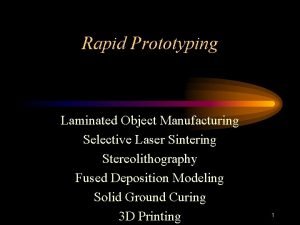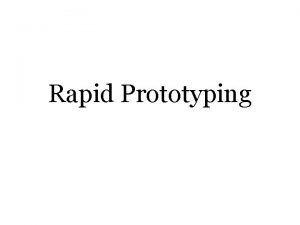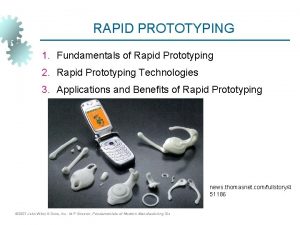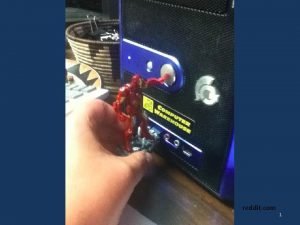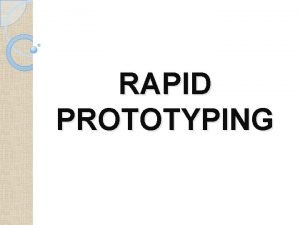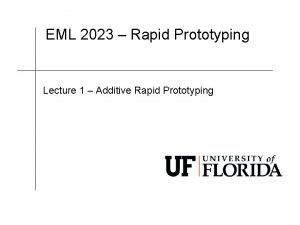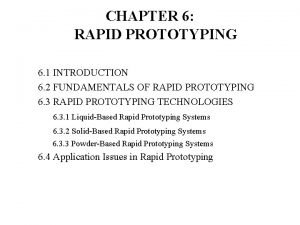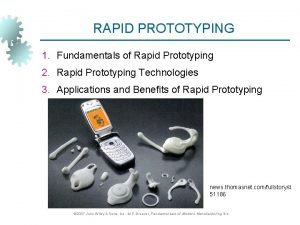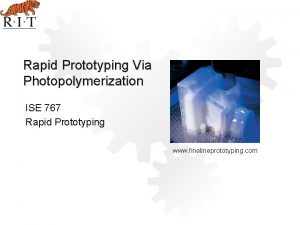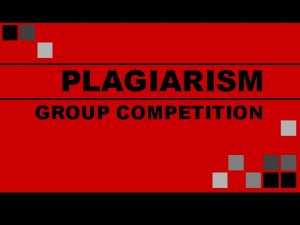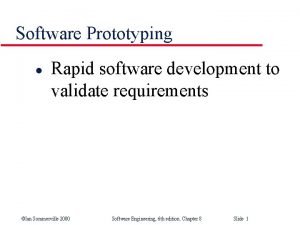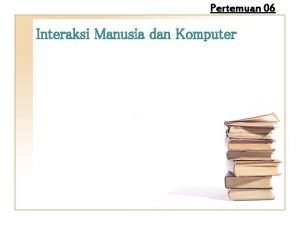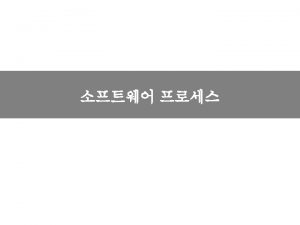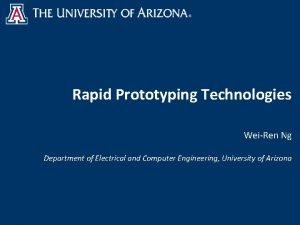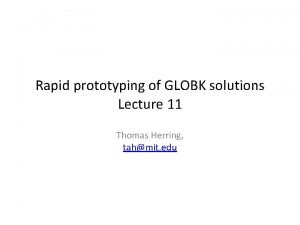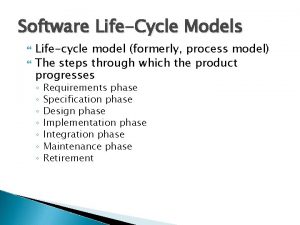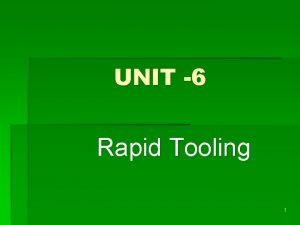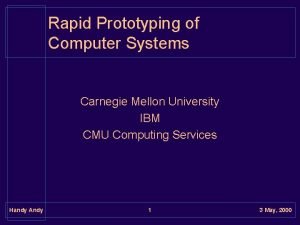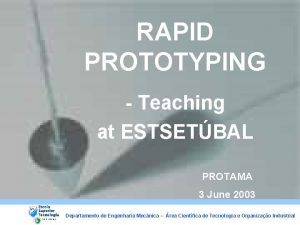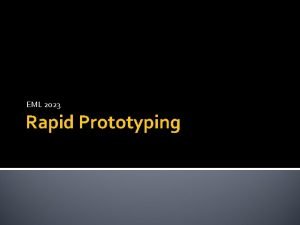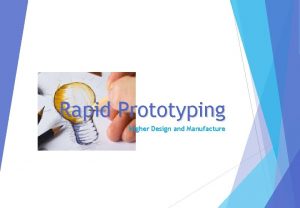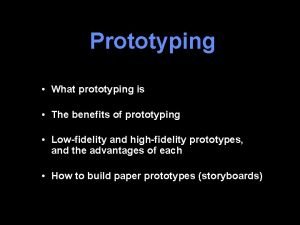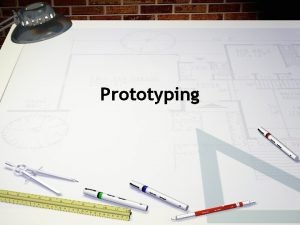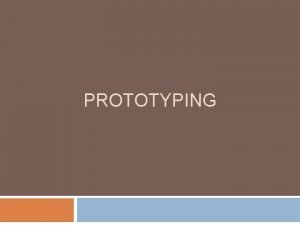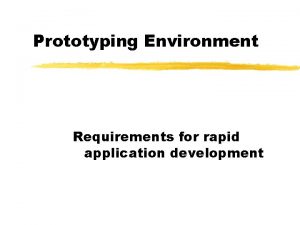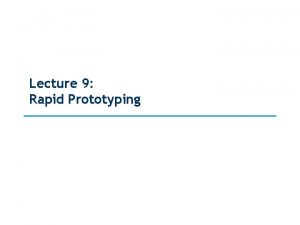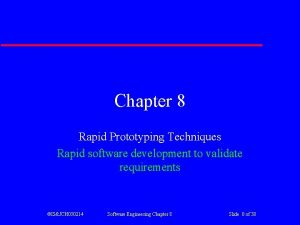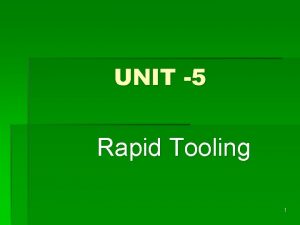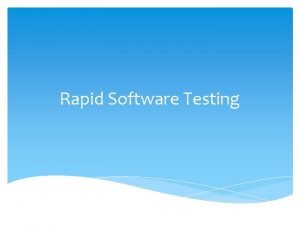Rapid Prototyping Technologies WeiRen Ng Department of Electrical





















- Slides: 21

Rapid Prototyping Technologies Wei-Ren Ng Department of Electrical and Computer Engineering, University of Arizona

Introduction • Rapid prototyping (RP) is a new manufacturing technique. – allows for fast fabrication of computer models designed with threedimension (3 D) computer aided design (CAD) software. • RP is used in a wide variety of industries, from shoe to car manufacturers. • Allows for fast realizations of ideas into functioning prototypes, shortening the design time – Lead towards successful final products

Introduction • Two general types: – Additive – Subtractive, • Subtractive type RP or traditional tooling manufacturing – a technique in which material is removed from a solid piece of material until the desired design remains. – Examples: • computer numerical control (CNC) • electric discharge machining (EDM). • Additive type RP is the opposite of subtractive type RP. – Instead of removing material, material is added layer upon layer to build up the desired design – Examples: • fused deposition modeling (FDM) • selective Laser Sintering (SLS)

DESIGN PROCESS

Design Steps • Process: – – Design CAD model Export as STL 2 D slices printing • Different types of RP technologies, all of them require the 3 D CAD model’s Stereolithography file for fabrication.

Stereolithography (STL) File Format • Stereolithography or Standard Tessellation Language (STL) file format. – only describes the surface geometry of a 3 D CAD model. – No information on the color, texture or material. – The surface geometry is described with triangular facets. • Each triangle facets uses a set of Cartesian coordinates to describe its three vertices and the surface normal vector using a right-hand rule for ordering.

Exporting STL from Solidworks • File Save as Change ‘Save as type’ to. STL • Select ‘Options’ for more advance export options. • Can select to export the STL as Binary or ASCII file format in millimeter, centimeter, inches or feet depending on the unit used in the CAD model.

STL File Format Tolerancing • Example of different STL tolerance

ADDITIVE RAPID PROTOTYPING SYSTEMS

Additive Rapid Prototyping Systems • The different types of additive RP technologies can be categorized into three types: 1. Liquid based (SLA and Inkjet based Printing) 2. Solid based (FDM) 3. Powder based (SLS) • Common components: – – Print tray Embedded computer for control systems Curing process – UV or laser Client computer – convert STL to 2 D print slices

Liquid based Additive Rapid Prototyping • Stereo. Lithography Apparatus (SLA)

Liquid based Additive Rapid Prototyping • INKJET BASED

Solid based Additive Rapid Prototyping • Fused Deposition Modeling FDM

Powder based Additive Rapid Prototyping • Selective Laser Sintering (SLS)

Comparison Build tray size (inches) System price range Speed Accuracy Surface Finish Strengths Weaknesses Available build material Stereolithography Aparatus (SLA) Inkjet Based Fused Deposition Modeling (FDM) Selective Laser Sintering (SLS) 20 x 24 12 x 6 x 9 24 x 20 x 24 27. 5 x 15 x 23 $75 K-800 K Average Very good Large part size Accuracy Post processing Messy liquids $46 K-80 K Poor Good to very good Accuracy Finish Speed Limited materials Part size • Polyester-based plastic • Investment casting wax $10 K-300 K Poor Fair Price Materials Speed Part size $200 K-1 M+ Average to good Good to very good Accuracy Materials Size and weight System price Surface finish • Nylon, including flameretardant, glass-, aluminum-, carbon-filled and others providing increased strength and other properties • Polystyrene (PS) • Elastomeric • Steel and stainless steel alloys • Bronze alloy • Cobalt-chrome alloy Titanium • • • Acrylics (fair selection) Clear and rigid ABS-like Polypropylene-like (PP) Flexible or elastomeric Water-resistant • ABS • Polycarbonate (PC) • Polyphenylsulfone Elastomer

OPTOMECHANICAL APPLICATIONS

Optomechanical Applications 3 D CAD design considerations: – – – RP fabrication tolerances – fitting and alignment Optical fine adjustment ability Stiffness of material to support heavy optical devices Fasteners Spacing Adhesion

Optomechanical examples • Zemax exported. STP file in Solidworks • Design integrated optomechanical parts around optics

Optomechanical examples • Spectral image classifier

Optomechanical examples • Adjustable camera mount

Conclusion • Advantages: – – Fast and inexpensive method of prototyping design ideas Allows for an integrated optomechanical design Multiple design iterations to finalize design Physical validation of design • Disadvantages: – Resolution not as fine as traditional machining (millimeter to submillimeter resolution) – Surface flatness is rough (dependant of material and type of RP)
 Lom rapid prototyping
Lom rapid prototyping Rapid prototyping definition
Rapid prototyping definition Powder based rapid prototyping
Powder based rapid prototyping Paper prototyping video
Paper prototyping video Rapid prototyping rp
Rapid prototyping rp Eml2023
Eml2023 Compare stl and slc file format
Compare stl and slc file format Introduction to rapid prototyping
Introduction to rapid prototyping Solid based rapid prototyping systems
Solid based rapid prototyping systems Photopolymer
Photopolymer Rapid prototyping could be an advantageous methodology
Rapid prototyping could be an advantageous methodology Rapid software prototyping
Rapid software prototyping Bentuk awal contoh atau standar ukuran dari sebuah
Bentuk awal contoh atau standar ukuran dari sebuah Prototyping methodology
Prototyping methodology Rapid prototyping wikipedia
Rapid prototyping wikipedia Rapid prototyping
Rapid prototyping Rapid prototyping
Rapid prototyping Software lifecycle models
Software lifecycle models Mexico rapid prototyping
Mexico rapid prototyping Rapid prototyping pro metal system
Rapid prototyping pro metal system Prototyping and rapid application development
Prototyping and rapid application development Cmu rapid prototyping
Cmu rapid prototyping
